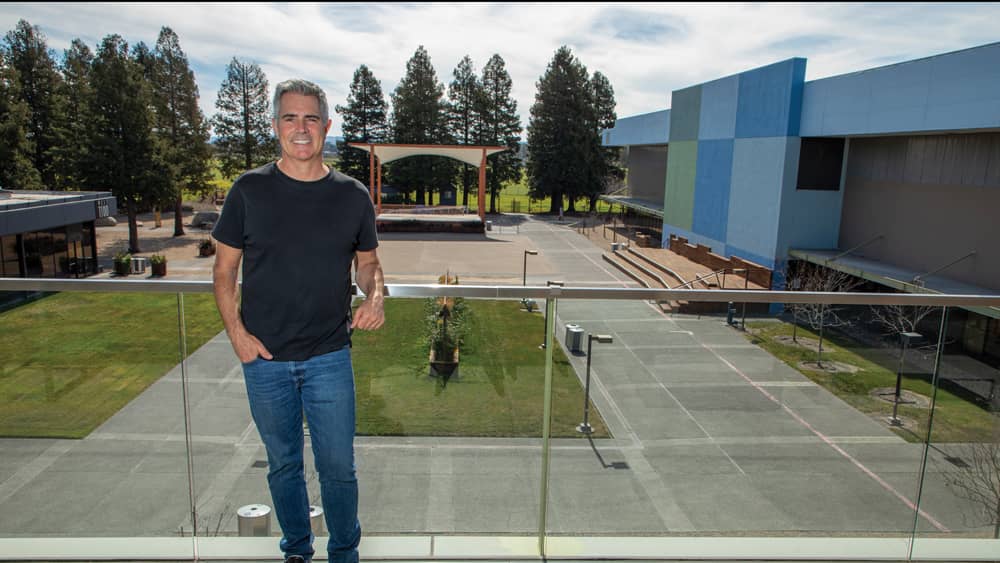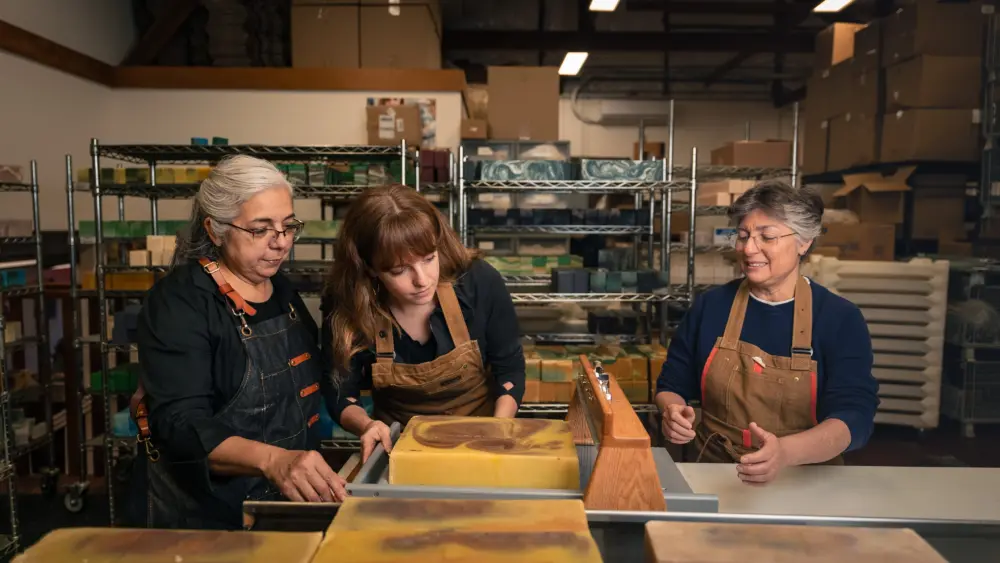
A brand-new neighborhood is on the rise in Rohnert Park. After 17 years, construction is about to begin on housing at SOMO Village, in the city’s southeastern corner, and the vision of a planned community with sustainability at its core is becoming a reality. It’s been a long time coming, but it’s a dream come true for SOMO Village’s CEO Brad Baker, and it’s a welcome addition to the City of Rohnert Park as well.
Innovation
The concept for SOMO Village began to take shape in 2005, when Codding Enterprises, a Santa Rosa firm headed by Lois and Lisa Codding, was in the running to purchase the 175.14-acre site from Agilent, a spin-off of Hewlett Packard, which had previously owned and occupied the site. When it decided to sell, Agilent sent a Request for Proposal to several real estate companies, and Codding Enterprises decided to pursue the opportunity. Agilent narrowed the field to three groups, of which Codding Enterprises was one, and asked each of the final bidders to submit a short essay describing what they would do with the property.
Codding Enterprises was involved principally in malls, but Brad Baker, who had become CEO several months earlier, suspected that with competition from companies like Amazon, the shopping center business could be facing rough times ahead. He believed diversification was a wise strategy, and so he wrote a business plan describing a mixed-use development that included businesses, restaurants, recreational activities and a residential component. The idea was that kids could go to school close to home, and residents would have easy access to amenities such as a coworking facility, a coffee shop, entertainment, food-and-wine events and a farmers market. “They could have somewhat of an urban lifestyle, but in a suburban setting,” he explains. And, equally important, the entire community would be sustainable. The proposal was convincing, and Codding Enterprises succeeded in acquiring the property, which consisted of several parcels and was then known as Sonoma Mountain Village.
Codding Enterprises submitted initial plans for redevelopment to the city in 2010, but the real estate industry was still experiencing challenges due to the financial crisis of 2007-2008 and the subsequent recession, and it took several years to recover. Consequently, the project languished until 2016, when SOMO Village became an independent development company. “My partners didn’t really have the appetite for it,” explains Baker, but he was committed, and he bought out Codding Enterprises and an equity partner and took ownership of the 175-acre development. The purchase required substantial capital. “As a result, we didn’t have a lot of money,” he says, and to raise the funds to go ahead with redevelopment, the new company needed to earn revenue by filling the existing six commercial buildings. By the beginning of 2022, five of them were 100% occupied, and one was two-thirds full. “By having the buildings full and making money, that’s enabled us to be in the financial position to finally move on the residential component,” he says. The tenants include food-related companies such as Morton & Bassett Spices, Traditional Medicinals and World Centric. “Most of our tenants have done relatively well during the pandemic,” he says, pointing out that because people weren’t going out, many of them spent more on quality products to use at home.
Building a community
When Hewlett Packard occupied the property, it erected a large fence and guard shacks to deter unwanted visitors. “It was a bit of a fortress out there,” says Baker. SOMO Village removed them and welcomed people to use the property’s trails and open space. Thus, when the COVID-19 pandemic forced parks and many outdoor spaces to close, they had a place where they could walk, enjoy the fresh air and exercise their dogs. “We built up a lot of good will,” he says.
Meanwhile, the vision for a sustainable community advanced. In January 2021, the Rohnert Park City Council approved final plans for 1,750 residential units, 38.54 acres of parks and open space to be built around the approx. 600,000 square feet of repurposed commercial buildings, which will have office space, coworking, a gym, coffee shop, a brewery, restaurants and bars. Next, work to ready the site for development began, setting the stage for the new community to grow. Crews broke ground in September 2021 and graded the area designated for construction, put in a sewer system, installed storm drains and provided access to domestic water. Dry utilities come next, and all power is electric from renewable sources—with no natural gas—in keeping with sustainable practices and a goal of zero-carbon energy. Baker expects the preparatory work to be completed by June, and a national homebuilder will start constructing homes in the summer. Completion of first phase of residential development is projected to be mid-2024, and the entire development will take 10 to 12 years.
Residences will consist of a mixture of apartments, townhouses and single-family homes with a variety of designs and color schemes. “We have such a large project, we’ll have all kinds of houses,” says Baker. Garages will be placed behind the homes rather than facing the street, with a system of alleys to provide access. “It’s not the traditional cookie-cutter way of doing things,” says Baker, explaining when garages are in the front, walking on the sidewalk is difficult. Starting in the 1950s, he adds, the focus was on the automobile, and it was a factor in design that made garages prominent. Baker wanted to take the emphasis away from cars, however, and create a better experience for pedestrians. “We think it’s a better aesthetic, and it makes for a better neighborhood,” he says.
As Baker and his team started filling the current buildings and planning for new commercial development, they recognized the need to set aside space for the type of businesses that would be desirable amenities for residents of a mixed-use community. Sally Tomatoes has been a popular fixture in the commercial complex on Valley House Drive since 2007 and consists of a catering service, Heritage Café and a large center for private and philanthropic events, and SOMO Village’s event center, which is also well established, features a 1-acre courtyard and 40-by-30-foot stage for professional entertainment. Stephen Marley will perform there in his Babylon by Bus Tour in June, and SOMO Village hosted Transcendence Theatre Company’s Broadway Holiday at the Drive-In in December 2020, when the local theater company was unable to use its usual venues as a result of COVID-19 restrictions. New businesses in various stages of development include a brewery, gym, coworking space and coffee shop. The coworking facility is under construction and will open first, and the coffee shop and brewery will begin operations this spring or summer. The intention is to make the commercial center a place that will be attractive to residents and meet their needs. “It’s really what we’re calling the hub of the community,” he says. “Kind of our downtown if you will.” He’d also like to have a market with good produce, meat and prepared food, and although a developer is interested in building one at the corner of Camino Colegio and Bodway Parkway, which Baker considers a good location, SOMO Village isn’t ready for a market yet.
SOMO Village is also home to Credo High School, a tuition-free, college-prep public charter school that offers a curriculum based on Waldorf principles. “It’s a great school. I’m a big fan of what they do over there,” says Baker, who would like to see a K-8 Waldorf school in SOMO Village as well. Discussions are ongoing, he says, but it would take several years to make an elementary school a reality, and it’s a goal for the future. Meanwhile, children could attend nearby Monte Vista Elementary School, which is within walking distance.
Sustainability
Sustainability is integral to SOMO Village, and much of the infrastructure was already in place when the company acquired the property. Baker explains that it was developed but not densely, and excess parking and some landscaping was suitable for turning into sites for housing in locations where residents can live a sustainable lifestyle by walking or cycling to access the services they need, instead of getting into a car. Building materials will come from sustainable sources, and all energy will be clean and renewable, provided by more than 3MW of on-site rooftop solar installations. Storm water is usually untreated and goes directly into rivers and streams, but retention ponds and bioswales with special soils and gravel will filter the water to remove substances like oil residue from cars to purify the water before releasing it into local waterways. In addition, a buffer zone will protect the California Tiger Salamander, which has a decreasing population and is considered vulnerable.
The design of the project is based on the principles of One Planet Living, and the U.S. Green Building Council’s Leadership for Energy and Environmental Design (LEED-ND) has recognized the project’s sustainable elements by certifying it as Platinum, its highest level.

In addition, “Food is a really big deal,” says Baker, noting that Sonoma County is synonymous with good food and wine. He’s enthusiastic about organic gardens that will provide food for the community and explains that SOMO Village replaced a lawn with a food forest that boasts orange, apple and nectarine trees and 600 blueberry bushes that he got from a farmer in Sebastopol, who had to remove them. Blueberry bushes need a lot of water, and to provide enough, the company will install a system to capture rainwater from the event center’s roof, which it collects in big storage tanks and uses to water the blueberries and other food plants. Credo High School has a 5,000-square-foot garden, and SOMO Village also has a small raised-bed vegetable garden as well. In addition, it owns a 25-acre parcel nearby in an unincorporated part of the county, and he would like to see a major sustainable farm there, with vegetables, an orchard, livestock and an educational component as well as facilities such as a barn. “That’s where I envision our major farm going,” he says. “That’s where you could make a big dent in feeding the community.”
Along with nutritious food, SOMO Village encourages walking and biking as part of a healthy lifestyle. The Cotati SMART station and Sonoma State University are a short walk away, and Baker is looking forward to the construction of SMART’S bicycle-pedestrian pathway, which will allow SOMO Village residents to go to Santa Rosa and Petaluma without getting into a car.
Health and happiness are a priority, and in addition to activities such as outdoor yoga classes, concerts and a wellness fair that took place in October 2021, art is prominent. It’s a passion for Baker, and he believes that experiencing public art is gratifying. “If you live in SOMO Village, you’ll have a lot of beautiful art,” he says, adding that a lot of wonderful pieces are behind locked gates where few people can enjoy them. A 10,000-square-foot contemporary art gallery is in the village center, and outdoor installations are scattered throughout the property and accessible to the public. Burning Man artists were short of work because of cancellations during the pandemic, and SOMO Village commissioned several projects from them. Some are in the process of being fabricated, and others have already been placed. One is a mammoth she-wolf, and kids’ eyes light up when they see it. Children can play on an installation of giant tomatoes and crawl on big rocks, which are natural art, and they have a great time. “Artists are talented people, and they love to have people enjoy their art,” says Baker, who is pleased to support them and offer art to the community.
Meeting needs
The Rohnert Park community is excited that the project is finally moving forward, and planning manager Jeffrey Beiswenger reports that the city expects to bring the design of the first 150 homes to the SOMO Village Design Review Board for consideration this spring. “A really nice thing about SOMO village is that it provides a brand-new neighborhood for Rohnert Park,” he says, observing that it’s urban in terms of density and housing type, making it different to the rest of the city with a compact walkable block pattern, and small parks sprinkled throughout. The project also features a significant amount of preserved natural open space areas. In addition, its commercial space is appealing. “It has a built-in town center with an existing commercial area,” he says, describing it as having a village-center atmosphere that will bring some additional commercial activity to that part of Rohnert Park.
The new housing will enhance the village ambience, and at the same time, with more than 1,700 varied residences, it will go a long way toward helping Rohnert Park meet its housing needs. “SOMO Village is very critical to our meeting the future housing needs of Rohnert Park, including affordable housing,” says Beiswenger. State Housing Law mandates that community provide for homes affordable to all income groups. The city is starting a process to update the housing element in its general plan. The Regional Housing Needs Assessment (RHNA) identifies the total number of housing units every local government must provide for, separating it into four affordability levels. The most recent plan was approved in 2014, and governments must now plan for the requisite amount of housing for the period from 2023 to 2031. The Association of Bay Area Governments determines the RHNA in the nine Bay Area counties, and Rohnert Park councilmember Susan Adams and Sonoma County supervisor David Rabbitt serve on the executive board.
For the people creating SOMO Village, though, it’s about community and quality of life. “A big part of what we’ve always tried to do is create community,” says Baker. People are looking for a community they can be proud of, with neighbors they like and amenities close by so they can walk to them. He expects the homes will appeal to a variety of people, including older folks, young families and those with diverse income levels. “I think we’ll hit all the major demographics.” He points out that Sonoma County has a big shortage of affordable housing, and so units to meet that need will come first, with larger, more spacious houses following. “We will get a broad swathe of folks interested in those affordable units,” he says, speculating that they might be teachers, firefighters and people who work in Sonoma County, but can’t afford to live locally and must commute long distances. Bus stops are nearby for those who want to use public transit.
“We’re looking forward to the next phase big time, which is getting this housing up and getting these amenities that we’ve been focusing on for the last year or so,” he says. He credits a team of people who like working together, enjoy the work and believe in the mission and making the idea of SOMO Village come to life. “It’s finally happening,” he says. “It’s been a long journey, but it’s been a good one.”

6 Essential Attributes of SOMO Village
- Walkable, bikeable, easy access to transit
- Multi-use public spaces
- Balance of land use with space for living, work, shopping, recreation, parks, education and culture
- Diversity of housing types, density and prices
- Art in public spaces
- Sustainable design according to the principles of One Planet Living
Source: SOMO Village
By the Numbers
SOMO Village consists of 175 acres made up of three parcels at the intersection of Bodway Pkwy. and Camino Colegio in southeastern Rohnert Park.
Large northern parcel: 98.06 acres
Southern parcel: 96.93 acres
Small northern parcel: 0.15 acres
The Final Development Plan shows a site capacity for a variety of housing types with a mixture of rental and housing for sale, totaling 1,750 units.
482 detached single-family units
382 townhomes
830 multifamily and mixed-use units
56 accessory dwelling units
If all 1,694 primary homes are built, 254 will be affordable dwelling units.
Space designated for commercial, office, retail and industrial use totals 823,000 square feet.
700,000 in existing buildings
103,000 newly constructed mixed-use retail
20,000 child care and fitness center space
Source: City of Rohnert Park, SOMO Village Final Development Plan



